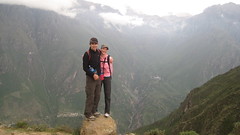Colca Canyon, Peru
 Friday to Sunday, 15-17 February 2008
Friday to Sunday, 15-17 February 2008We do a 3-day trek in the Colca Canyon. With a depth of 3191m, it is the world's second deepest canyon. Our guide from the Colca Trek company is Jenny, who is absolutely brilliant. We are lucky too with our travel companions - friendly fellows Hugo (from Strasbourg) and Sebastien (Montreal). The starting point of the trek is the village of Cabanaconde (a 6-hour bus journey from Arequipa). This is at an altitude of 3290 metres so after a few minutes and very little exertion, the lungs are heaving and heart thumping. Hugo supplies us with coca leaves, the traditional remedy for altitude sickness. He was told by the guy who sold it to him to eat the leaves whole. Hugo is outraged to hear from Jenny that the proper way of using the leaves is to roll up a thumb-sized amount and place it between your gums and the inside of your mouth. You can then suck on the sillage-flavoured juice for a good half hour then with the desired effect. Hugo admits, using alot of French expletives, to having eaten about a kilo of the stuff on the other guy's recommendation and not feeling well after it. We learn the meaning of the French word "putain". On the first day we trek downhill for about 4 hours. The scenery is breathtaking - vaulting mountains, drifting clouds at eye-level and steep drops into the canyon below. The path is wide enough for just one person, is not paved and so alot of the time is spent concentrating on the ground at your feet trying not to slip on shale or loose stones that litter the path. We have the trek pretty much to ourselves apart from the the local farmers who surge by with their donkeys carrying supplies to and from the villages that hug the sides of the canyon. (Apparently the trek that we are doing over 2 days can be done by the local champion in 2 hours.) The accommodation at the bottom of the canyon on the first night is basic but the location is idyllic. It's in a village of 40 inhabitants. The flower garden at the hostel is in full multicoloured bloom and we are woken the next morning by the low hum of bees. On this second day, we continue the trek, stopping along the way to have a snack of cactus fruit (hard to describe - semi-hard to chew on, very juicy, apparently not hallucinogenic). We also visit a museum in one of the villages. It's a small room but a local woman, dressed in the traditional kaleidoscope-coloured outfits of Peru, explains to us the various tools the villagers use and have used in the past to sow and harvest crops and the different types of foods they live off. The villages that line the canyon were badly damaged by an earthquake in 2001 so we see the rebuilding that has taken place in the meantime. Three hours later, after a few near-vertical climbs, we arrive at what the tourists call the "Oasis". Situated right at the bottom of the canyon, it's a lush green area where a hostel and swimming pool have been built by some enterprising folk. We have lunch here and steel ourselves for the ascent back up to Cabanaconde. It's a tough climb but we take plenty of breaks on the way up. Without looking around, Jenny just seems to know how far she can drag the group up the hill before we need a breather. It may be the alternate hyperventilating, death-rattles and cries of "putain" behind her that give the clue. We overnight in good lodgings in Cabanaconde. The next morning, on our way back to Arequipa, we stop off at Cruz del Condor, a viewing point for the condors that soar above the canyon. Much like our attempt at albatross-watching in Dunedin, plenty of patience is required, and we wait an hour before one of them shoots close overhead. Sebastien is the only one who is quick enough to capture it on camera. Resigned to having seen only one bird, we hop on the bus back to Arequipa. As we pull away a couple of condors come into view and hover above the viewing area. Talk about timing!
If you want to see photos, click here.

0 Comments:
Post a Comment
<< Home